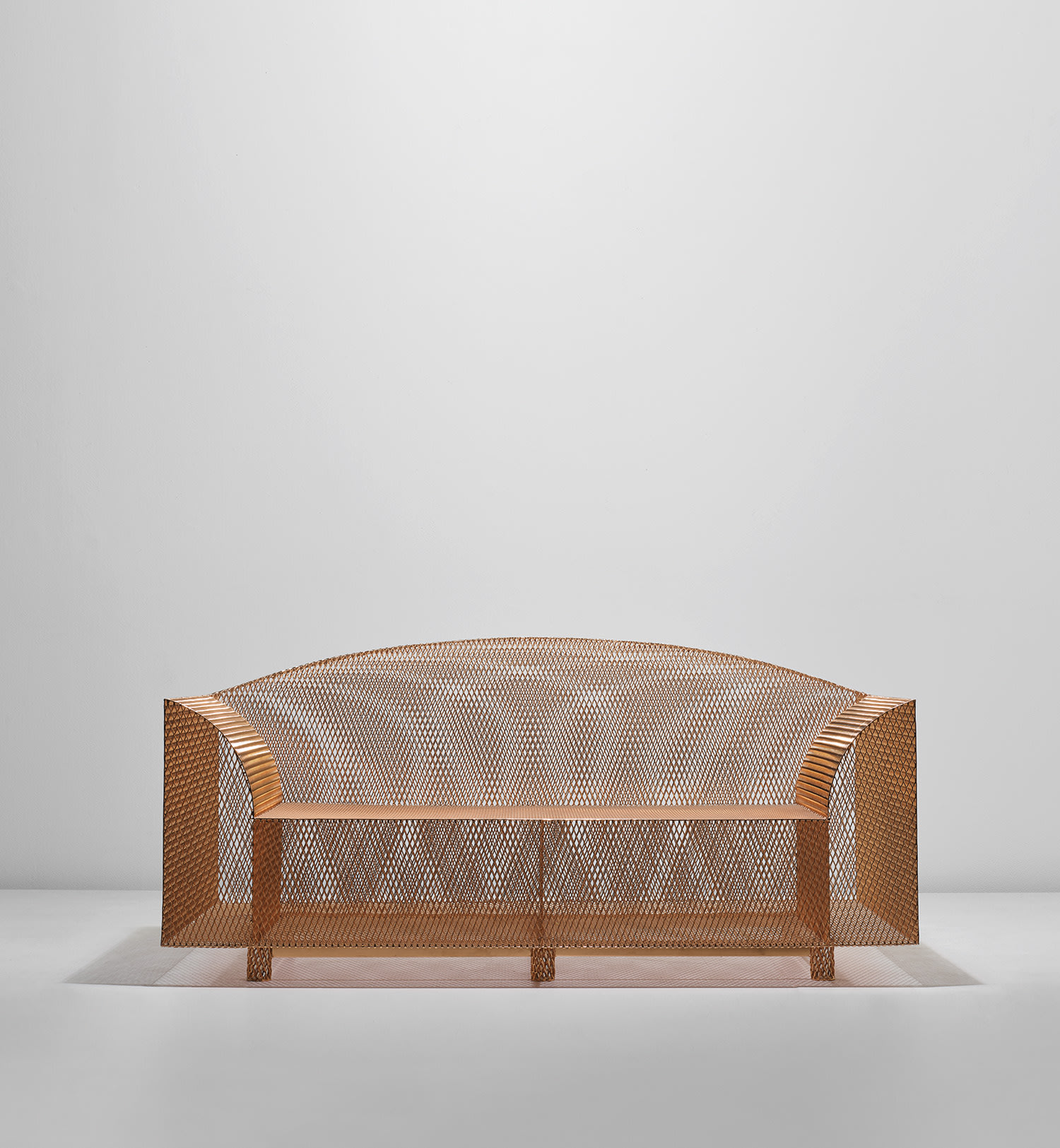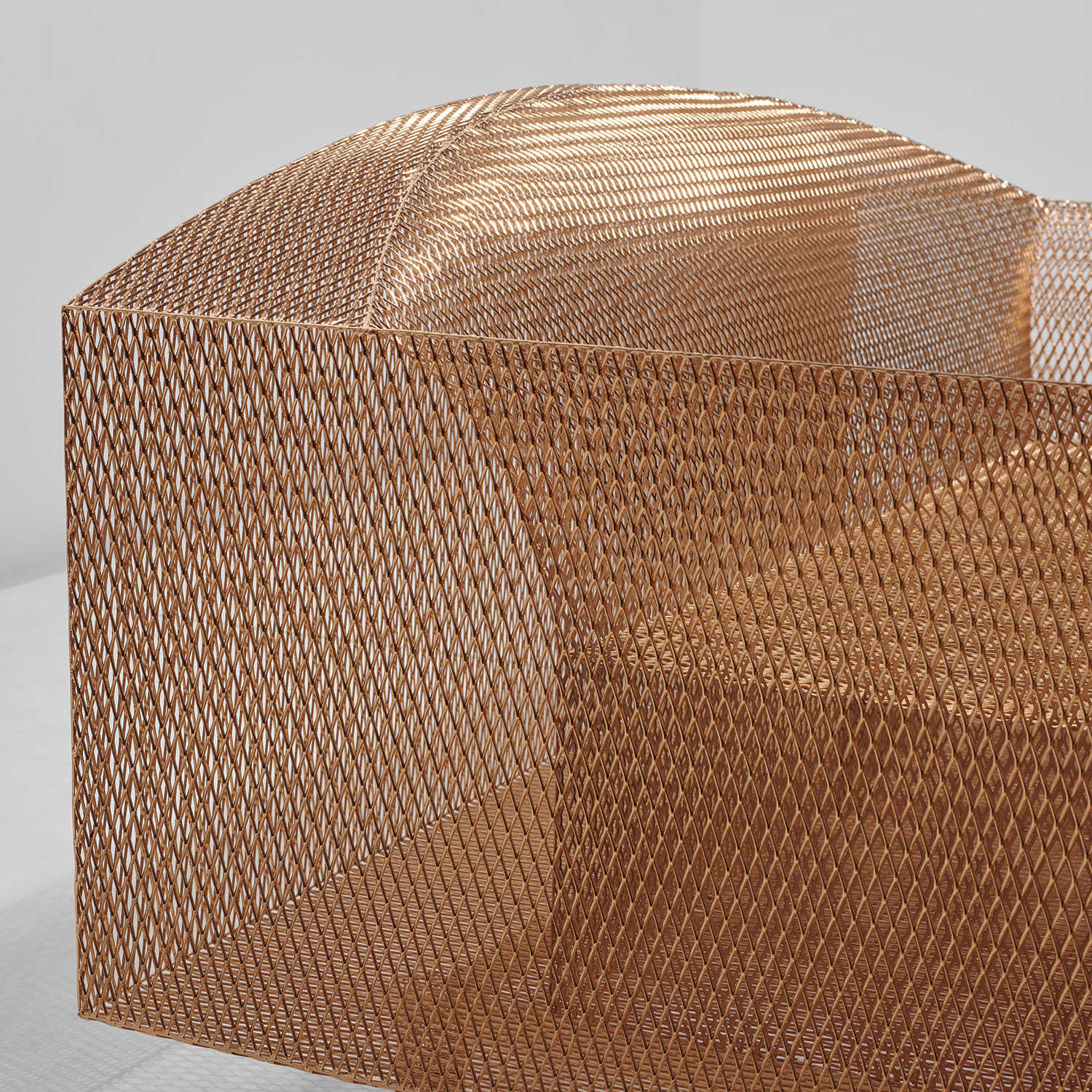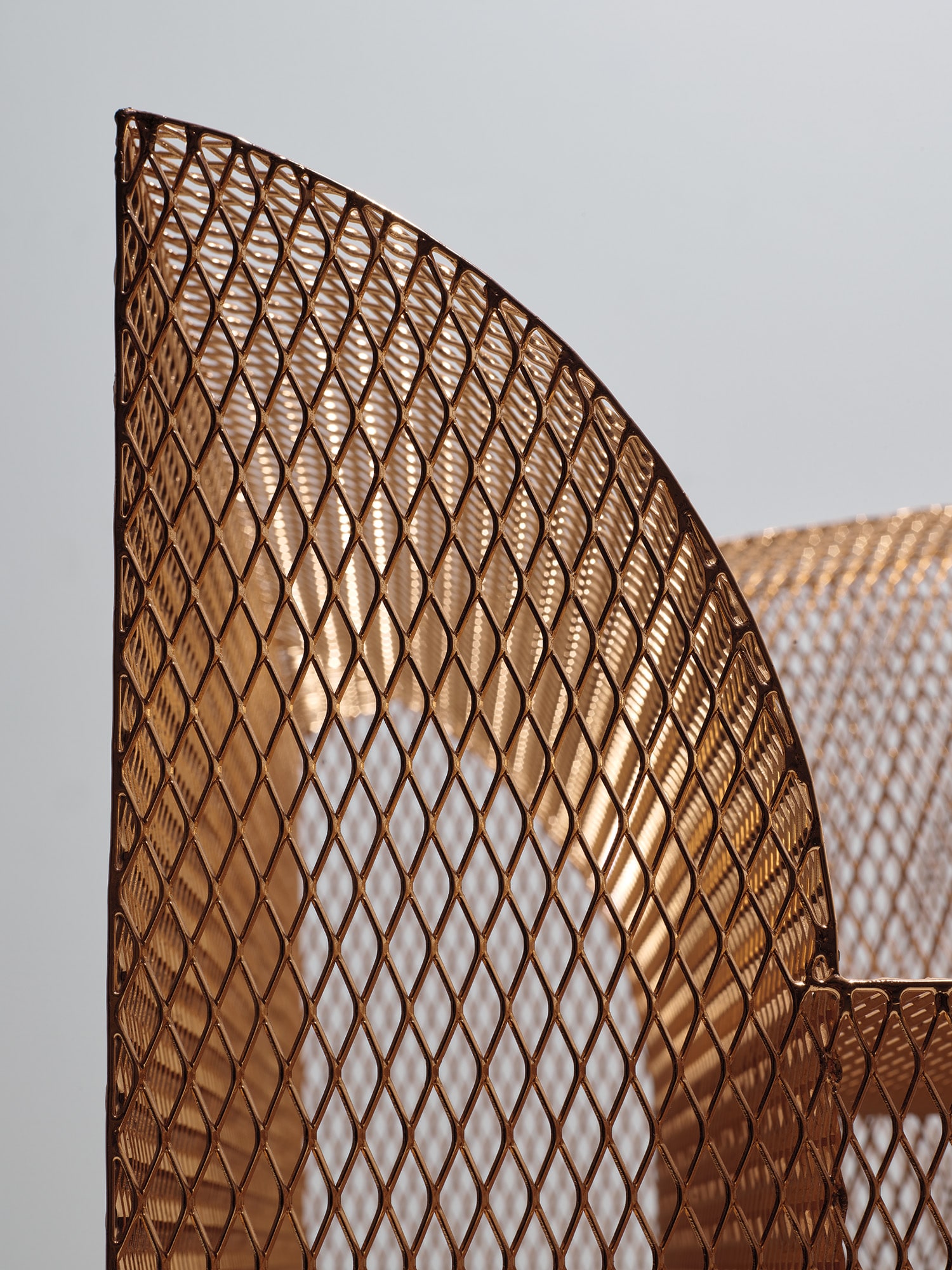







78
Shiro Kuramata
‘How High the Moon’ two-seater sofa
Full-Cataloguing
By Luke T. Baker
Somewhere there's music
It's where you are.
Somewhere there's heaven
How near, how far.
The darkest night would shine
If you would come to me soon.
Until you will, how still my heart
How high the moon.
The wistful jazz standard How High the Moon, penned in 1940 by lyricist Nancy Hamilton and once a staple in Ella Fitzgerald’s repertoire, is an apt title for Shiro Kuramata’s iconic, nearly translucent sofa made from copper‐plated metal mesh. Like the song about longing after a distant love, this ghostly object seems to recall something familiar but still far away. We can discern its gauzy silhouette, as though coaxed from the depths of memory, but its form appears not quite tangible. Since its debut in 1986, 'How High the Moon' has been an emblem of 20th century design, and remains a masterwork within the Japanese designer’s oeuvre, which encompassed designs for furniture, lighting, objects, and some 300 interiors. It’s consummate Kuramata: minimal and serene at first glance, yet imbued with aspects of whimsy, illusion, and reference, themes that would resonate in Kuramata’s works until his death in 1991.
'How High the Moon' gracefully displays the designer’s affinity for expanded metal mesh, one of the industrial materials he began working with extensively starting in the mid 1980s. Made from sheet steel that’s been slit and stretched into a grid of diamond‐shaped voids, expanded metal mesh is strong, yet lightweight and permeable—ideal for applications like fences, plaster walls, or factory catwalks. Such industrial materials were loaded with significance for many Japanese artists and designers of Kuramata’s generation, who came of age during the post‐war years of intensive urbanisation and Westernisation. While contemporaneous art movements such as Mono‐ha appropriated raw artefacts of industry as a comment on Japan’s rapid transformation, Kuramata’s works instead sought to recontextualise plate glass, metal mesh, and anodised aluminum in unexpected domestic applications. By elevating these workaday materials and shedding light (quite literally) on their inherent beauty, Kuramata’s designs transformed the cold and inorganic into something evocative and charded with emotion. Expanded metal mesh was used for elements of his '45º Latitude' table (1985), 'Sing Sing' and 'Hal' chairs (1985 and 1987), and as the central feature of his 1987 Shibuya store for friend and collaborator Issey Miyake, but the 'How High the Moon' sofa and armchair were the only objects he created almost exclusively from the material.
At once voluminous and weightless, Kuramata’s surrealistic sofa plays a trick on the senses. The designer was drawn to mesh as an ethereal material characterised primarily by its absence, 'a plane that barely holds itself up after all excess parts have been subtracted' (Shiro Kuramata, Hara Museum of Contemporary Art, 1996). Working with mesh, glass, and later, acrylic, allowed Kuramata to create ‘invisible’ objects that by turns stand out and blend into the background. 'How High the Moon' traces the outline of an overstuffed sofa—that Platonic ideal of bourgeoise Western domesticity and leisure—to create both shell and symbol, a hollowed out form steeped in nostalgia. Throughout his career, Kuramata’s designs would push the limits of reductivity and reference. His 'Glass' chair of 1976 or 'Homage to Josef Hoffmann' chairs of 1985 and 1986 show the designer abstracting or dematerialising objects down to their most essential shapes, while maintaining the allusion to an imagined whole.
A sofa created from elemental planes of industrial steel mesh would seem the ultimate minimalist’s couch—bested perhaps only by the spartan and boxlike wooden furnishings of Donald Judd—but Kuramata himself did not think of 'How High the Moon' as devoid of the decorative. Rather, he used mesh to explore his penchant for expressive linearity, treating it with shiny coatings like copper plate that maximise the dazzling effects of light and make the surface glint like beads of dew on a spiderweb. The mesh serves as both exoskeletal structure and surface decoration, its geometric repeat suggestive of a printed textile or even the dimpled, button‐tufted upholstery of a classic Chesterfield. The dynamic pattern of intersecting lines cause a moiré effect that visually vibrates as you approach the object, and creates shadows that fall onto nearby surfaces, creeping and elongating with the shifting sunlight. 'The concept of decoration is weak inside me, but by using mesh that proliferates like a cell within the process of eliminating, I'm discovering my own style of decoration,' he noted (Shiro Kuramata, Hara Museum of Contemporary Art, 1996). Many of Kuramata’s most powerful designs embrace ornament that is incidental and often intrinsic to the material itself—whether the lace‐like craquelure of shattered sheet glass in his 'Sally' table (1987), or the red roses encased within the clear acrylic slabs of his iconic 'Miss Blanche' chair (1988).
Works like 'How High the Moon' embody Kuramata’s approach to designing objects with the imaginative spirit of a poet. From a sheet of penny‐colored cut steel, he evokes a fantastical rumination on a sofa, the domestic archetype rendered as a shimmering mirage—how near, how far.
Shiro Kuramata
Japanese | B. 1934 D. 1991Shiro Kuramata is widely admired for his ability to free his designs from gravity and use materials in ways that defied convention. After a restless childhood, his ideas of being an illustrator having been discouraged, Kuramata discovered design during his time at the Teikoku Kizai Furniture Factory in Arakawa-ku in 1954. The next year he started formal training at the Department of Interior Design at the Kuwasawa Design Institute. His early work centered on commercial interiors and window displays. In 1965, at the age of 31, he opened his own firm: Kuramata Design Office.
Throughout his career he found inspiration in many places, including the work of Italian designers (particularly those embodying the Memphis style) and American conceptual artists like Donald Judd, and combined such inspirations with his own ingenuity and creativity. His dynamic use of materials, particularly those that were transparent, combination of surfaces and awareness of the potential of light in design led him to create objects that stretched structural boundaries and were also visually captivating. These qualities are embodied in his famous Glass Chair (1976).